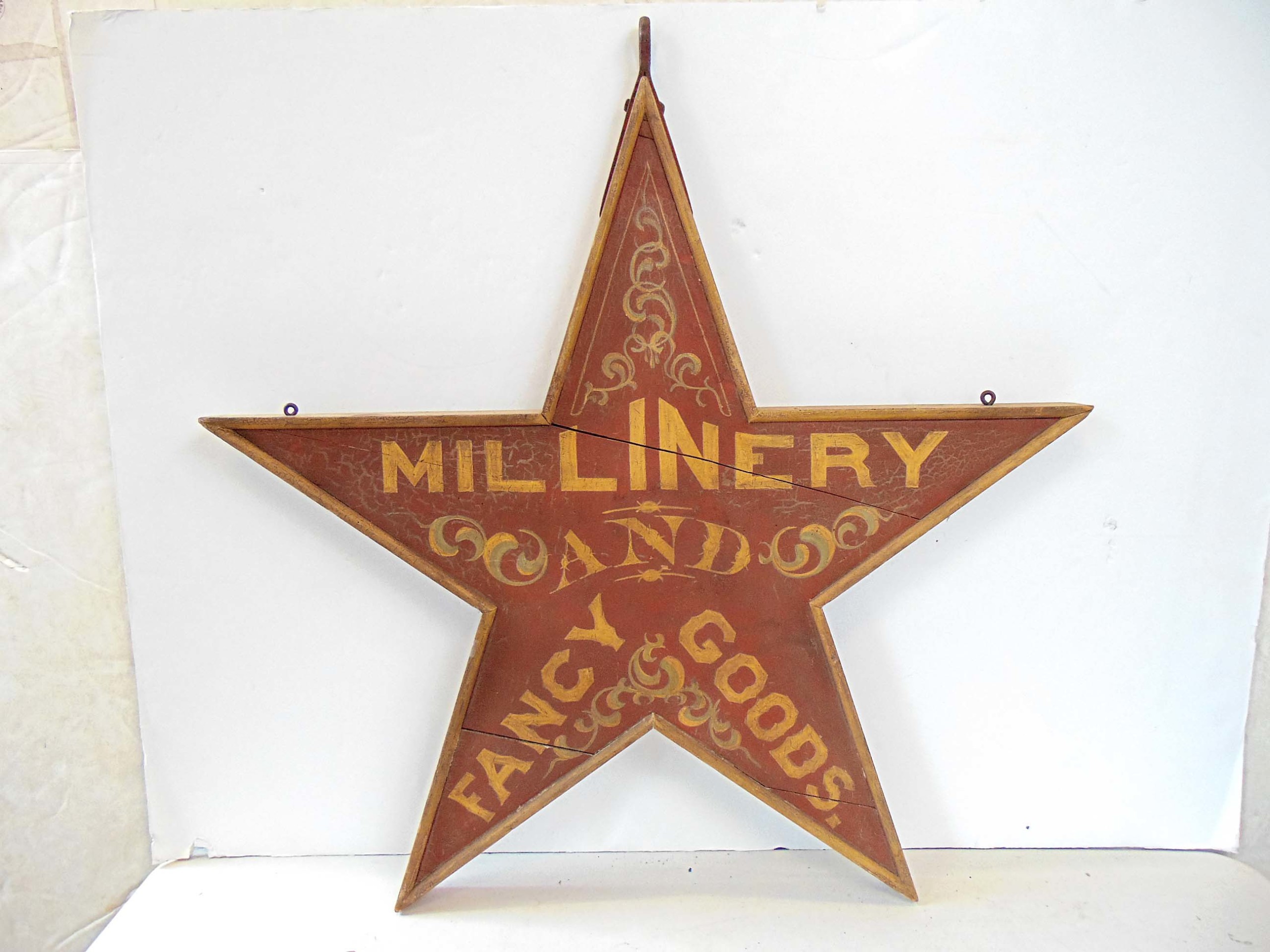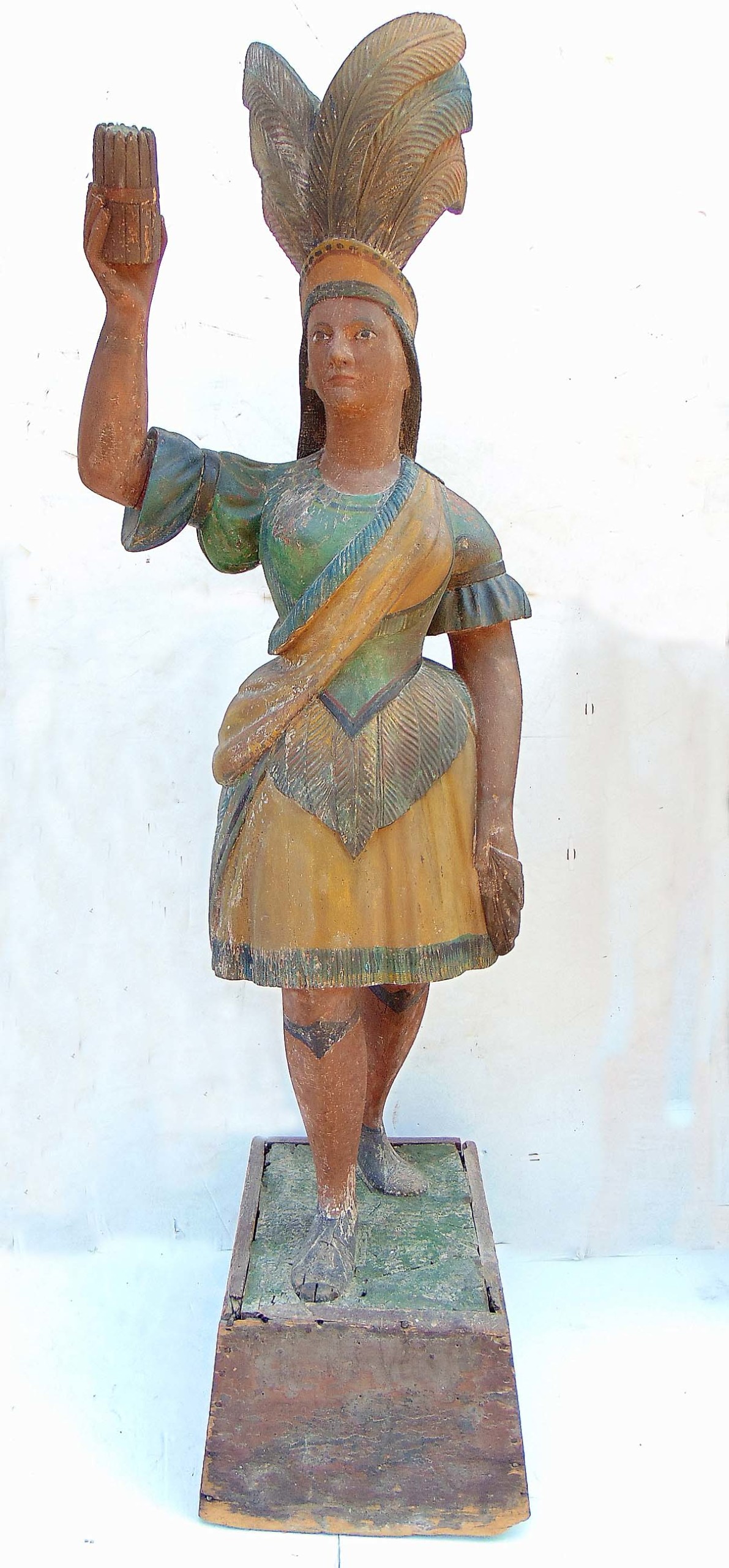
Like a star atop the Christmas tree, this Nineteenth Century millinery trade sign, double-sided and star-shaped, was at the apex of the sale. Made of painted-wood with gilt letters proclaiming, “Millinery And Fancy Goods,” it sold to folk art dealer Allan Katz for $40,000.
Review by W.A. Demers
BEACON, N.Y. — “As expected, this was a very good sale, and attendance and participation were excellent,” said Theo De Haas, Hudson Valley Auctioneers’ sales manager, regarding the September 23 sale of the art and folk art from the Alfred Selnick estate. The trade held sway, although there was private collector action as well, according to De Haas. Although the firm declined to provide a sale total, the sell-through rate was 100 percent for the 292 lots on offer. A total of 700 bidders registered through LiveAuctioneers and there were between 20-30 bidders in house and about the same number bidding by phone or absentee.
The top lot was a Nineteenth Century millinery trade sign, double sided and star shaped, made of painted wood with gilt letters proclaiming, “Millinery And Fancy Goods,” which sold for $40,000 to Allan Katz bidding on the floor. “Bidding went pretty high,” said De Haas. “There was another guy, a person from Wisconsin, and he really wanted it because his client had apparently owned it in the past. He called me a day after the sale and told me he was heart-broken. He really wanted it but couldn’t go any higher.”
The sale was devoted to American portraits and paintings, folk art and signs from the Selnick estate. Selnick began his working career in a contractor’s office, followed by an eight-year stint with an architectural-engineering firm. His interest in collecting folk art began in the late 1960s after meeting Phyliss Solomon, who had become a volunteer at the American Folk Art Museum in New York City and had begun collecting American portraiture. Their home and adjoining gallery on a mountainside in Hillsdale, designed by Selnick, displayed both of their collections. The auction combined these collections, offering a cataloged sale of artwork, folk art and signage, followed by an uncataloged session of various other items.

This Native American princess cigar store trade figure was deemed to be in excellent original condition. The 69-inch-tall figure held a bundle of cigars aloft in her right hand and came with its display base. It sold to Allan Katz for $27,500.
A Native American princess cigar store trade figure was deemed to be in excellent original condition. Standing 69 inches tall, the figure, right arm holding a bundle of cigars aloft, came with its display base and also sold to Katz for a within-estimate $27,500. “Bidding activity was pretty heavy on this lot as well,” said De Haas. While these figures, both male and female versions, come to auction from time to time, their value is determined by condition, artistry and quality of the carving, as well as who it was carved by. “I had about eight bids on this, and they were good bids,” said De Haas.
Another trade sign, this one advertising “The Alaska Fur Company” with a gilded seal and gold lettering on a black background, was bid to $23,750. The carved- and painted-wood, double-sided full body sign hung from an iron bracket and measured 75½ by 75 inches. “That was a nice piece,” observed De Haas. “It was big. He [Selnick] had a large barn built, set up almost like a museum, and this piece was hanging right above the staircase.” The auction catalog noted it was “ex Sotheby’s.” It was also purchased by Katz, who told Antiques and The Arts Weekly after the sale he had bought about 15 lots, for inventory.
An unassuming trade sign, estimated at just $600/800, indicated the “F.H. Juergensen Palace Saloon.” The double-sided painted wood sign, measuring 23 by 95 inches, surprised at $19,375. “It sold to the phone to a gentleman from Texas, who apparently was familiar with this sign,” said De Haas. “I guess it originally was from Texas. He actually drove up from Texas to pick it up over the weekend.”

Estimated at just $600/800, this “F.H. Juergensen Palace Saloon” double-sided painted-wood sign, 23 by 95 inches, surprised at $19,375.
Catalog notes said a 35-inch-high trade wood carving of a steer, fitted with steer horns and original paint and varnish, was possibly from St Louis, Mo., circa 1880. It rounded up a winning bid of $15,625, selling to the Connecticut trade bidding on the floor.
Bidders liked a tombstone-shaped toll sign from the early Nineteenth Century, which was estimated $1,8/2,200 but did much better, finishing at $13,750 and selling to a dealer. Possibly mounted at the entrance to a bridge or ferry, the painted wooden sign listed “Rates of Toll” ranging from a horse and conveyance (38 cents) to sheep and swine (1 cent). It measured 29 by 42 inches.
A trade sign advertising “John A. Moran Fine Clothing Hats And Furnishings,” a tour de force of typography and color, featured a wire body with carved and painted frame and applied tin banners with gold lettering. Measuring 58 by 71 inches, it went out at $11,875. “It was a beautiful sign, large, double sided,” said De Haas. “A very striking sign. It was a dealer who bought it, as well as three or four other signs.”
Fetching $11,250 was a carved gilt wood arm and hand pointing sign, stretching out to 72 inches and proclaiming sign for “Opera House One Price Clothing Hall.” It sold to a couple from California bidding on LiveAuctioneers.
Prices given include the buyer’s premium as stated by the auction house. The next sale is October 21 with more from the Selnick collection, including Midcentury Modern and an early Twentieth Century Steinway piano. For information, www.hudsonvalleyauctioneers.com or 845-831-6800.




